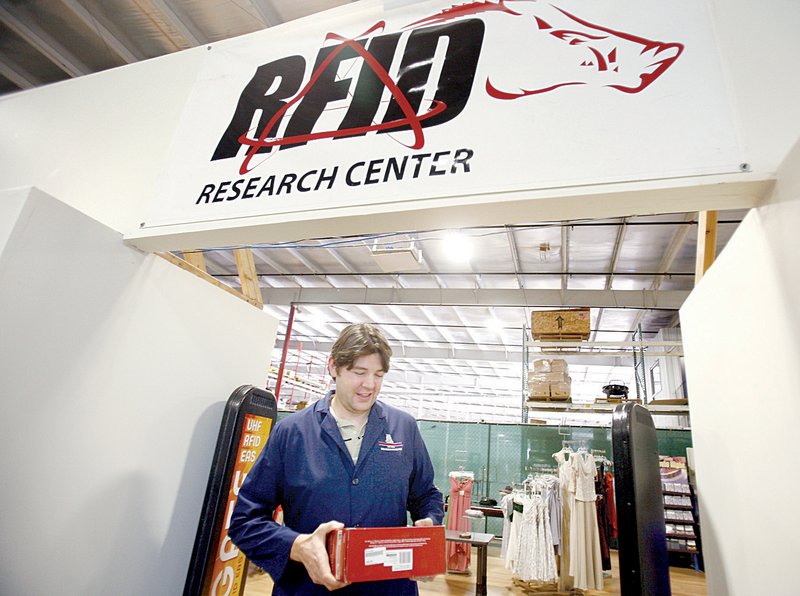LITTLE ROCK — Research at a University of Arkansas at Fayetteville technology laboratory on tracking the movement of retail merchandise is shifting from the store and distribution-center level to the entire retail supply chain.
The shift comes after several studies at the RFID Research Center have shown a significant increase in inventory accuracy at the destination sites. RFID is radio-frequency identification.
Bill Hardgrave, the soonto-depart executive director of the center, says tagging retail items where they originate - at factories around the globe - is essential to realizing the potential of the technology.
“Ultimately, for RFID to provide maximum value, that’s what we have to do,” he said. Hardgrave will leave his position at the center, part of the university’s Information Technology Research Institute that he also heads, on July 31 to become dean of Auburn University’s College of Business.
With the use of radio-frequency identification, tiny tags known as transponders are attached to items headed for sale at retail outlets. The tags emit signals that are received by stationary or hand-held devices.
The technology, if fully utilized, could provide retailers and other businesses a constantly updated inventory of products, equipment or anything to which the tags are attached.
Despite the recession, use of radio-frequency-identification technology is poised to increase sharply, said DrewNathanson, senior radio-frequency-identification analyst and director of research operations at VDC Research GroupInc. in Natick, Mass.
“This year is turning out to be a really big, blockbuster year for RFID in retailing,” hesaid. When he received the data for the company’s annual radio-frequency-identification survey, he said, “I couldn’t believe the numbers that were coming out from retail.”
VDC Research specializes in technology research and consulting.
Budgets allocated for radio-frequency identification in retailing for this year showed triple-digit increases in many cases, Nathanson said, and most of that was for existing accounts, indicating that current users are expanding rapidly.
The firm forecasts that retailer spending on radiofrequency-identification tags globally will increase from $68.4 million in 2009 to $258.3 million in 2014. The numberof units is forecast to increase at an even greater rate as the cost per unit comes down. The tags currently cost about 7 cents each.
Wal-Mart Stores Inc. of Bentonville helped push the envelope on radio-frequencyidentification development several years ago by requiring major suppliers to use the tags.
“We know the technology works and have been working with suppliers to integrate EPC [electronic product code] in our business, just as we always said we would do,” spokesman Dan Fogleman said.
Implementation of radiofrequency identification has come with occasional glitches.Last year, key Wal-Mart supplier Procter & Gamble Co. of Cincinnati pulled out of a joint project with the retailer on radio-frequency-identificationtagged promotional displays, saying the materials failed to reach sales floors in a timely manner.
The two companies remain closely linked and are funding a series of family friendly, made-for-TV movies.
The RFID center’s most recent project, with J.C. Penney Co. of Plano, Texas, focused on tagging apparel items, which Hardgrave calls “RFID friendly” as opposed to, say, a bottle of ketchup. Apparel items are easy to tag and have a higher value than most food items.
And from a shopper’s perspective, he said, a customer likely would be looking for a particular style of jeans in a specific size, and “if you don’t have it, they’re not going to buy something else.” Ketchup, another brand likely would suffice.
Previous RFID center studies at other retailers found inventory accuracy rates in apparel to be about 62 percent, “and these are industry leaders,” Hardgrave said, includingWal-Mart, Dillard’s, Bloomingdales and American Apparel.
“They didn’t get to be industry titans by doing things poorly,” he said.
At the Penney test stores, apparel inventory accuracy rates were boosted above 90 percent. Penney did not respond to telephone and e-mail requests for comment about the study.
Widespread use of radiofrequency-identification tags for grocery items likely is five to seven years away, Hardgrave said.
Mark Roberti, editor of the trade publication RFID Journal, said that, despite the radio-frequency-identification growth tracked by VDC Research, some companies pulled back from radio-frequency identification because of the economy.
“We saw projects getting put on hold last year. I think that’s still the case in many companies. Other companies have started to re-establish those plans,” he said.
But the apparel sector appears to be an exception, he said, with some retailers running tests internally to see if they can duplicate the benefits that the research center found in its tests.
Hardgrave said the retail industry likely has some hurdlesto clear as it pushes for radiofrequency-identification tags to be added at manufacturing plants globally. Many of the factories are in the Far East or Central or South America and are functioning at a lower level of technology.
A push for factory-level tagging, involving teams from retailers and apparel manufacturers, is under way, he said.
With Hardgrave’s coming departure, Moez Limayem, information systems department chairman, will become interim director of the Information Technology Research Institute. Matthew Waller, who holds the Garrison Endowed Chair in Supply Chain Management, also will handle some of Hardgrave’s duties.
At Auburn, Hardgave said, he intends to stay involved in radio-frequency-identification development, though he’s not sure what that role might be. He doesn’t intend to create another research laboratory, he said.
“I’m going to see this thing through,” he said. “I have no intention of leaving the industry.”
Business, Pages 65 on 07/18/2010
